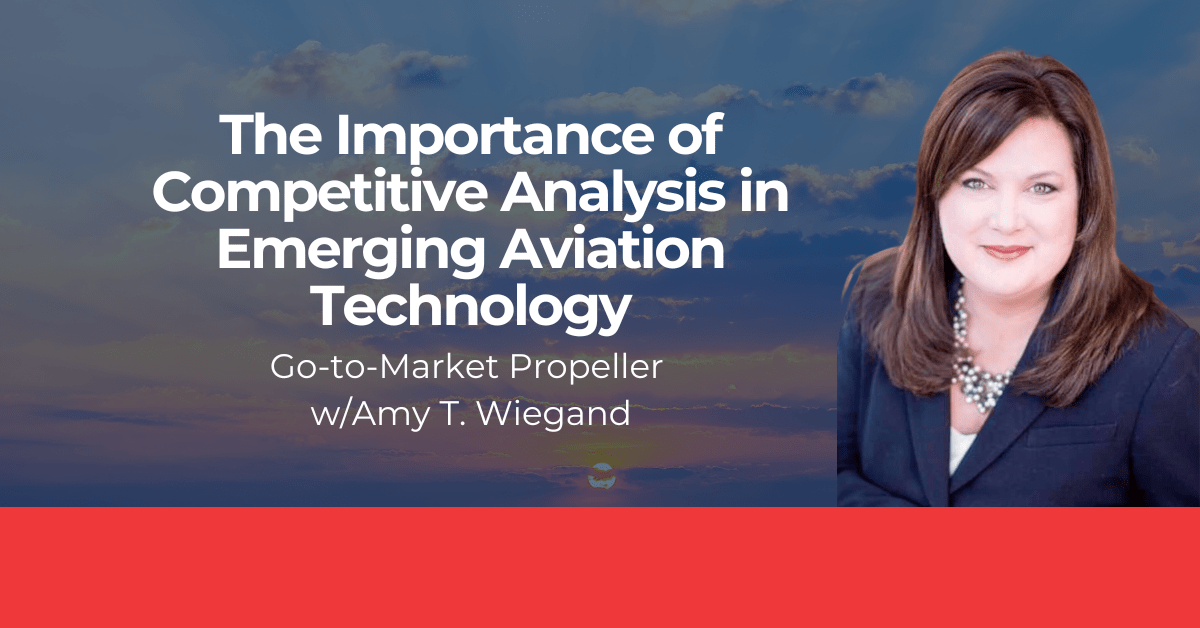 The latest in an occasional column on bringing products to market in emerging technologies, by industry marketing expert Amy T. Wiegand: Go-to-Market Propeller. Go-to-Market Propeller is the practical support a growing industry needs – getting from innovation to sales. In this article: the importance of competitive analysis.
The latest in an occasional column on bringing products to market in emerging technologies, by industry marketing expert Amy T. Wiegand: Go-to-Market Propeller. Go-to-Market Propeller is the practical support a growing industry needs – getting from innovation to sales. In this article: the importance of competitive analysis.
by Amy T. Wiegand
Competitive analysis solidifies the foundation for strategic decision-making, especially in engineering-driven industries where innovation and differentiation are critical. This research process systematically assesses competitors’ strengths, weaknesses, products, and market positioning to gain actionable insights that guide development, marketing, and business objectives. It also prepares sales teams to understand customer objections to their products and services and know their competitors.
Why Competitive Analysis Matters
For tech teams, competitive analysis is not just a business exercise—it provides critical insights into technical trends, customer needs, and performance benchmarks. It enables teams to identify gaps in the market, avoid redundancy, and develop truly innovative and value-driven solutions. In technology industries, staying ahead requires understanding not only what competitors offer but also how they deliver value, what technologies they leverage, and where they fall short.
This research is particularly vital for emerging aviation technologies, where competition is fierce, regulation is evolving, and technological breakthroughs redefine the landscape. Uncrewed aerial systems (UASs), advanced air mobility (AAM), robotics, and drone integration into critical sectors like governments, public safety, utilities, energy, and telecom demand sophisticated solutions. A robust competitive analysis allows stakeholders to navigate these complexities, anticipate market shifts, and position their offerings to meet unmet and competitive needs.
Conducting Competitive Analysis
A thorough competitive analysis typically involves these key steps:
- Understand Your Business Objectives – Align your team with the benchmarks, objectives, goals, and expected outcomes.
- Identify Competitors: This includes direct competitors and alternative solutions. For aviation technology, this could range from manufacturers of hardware to software providers specializing in UASs, AAM, and airspace management.
- Define Research Criteria: Identify what you aim to learn from the competitive analysis—market gaps, technological trends, feature differentiation, or competitor strengths and weaknesses.
- Gather Data: Use publicly available resources like patents, product reviews, and company and industry reports, as well as customer feedback, expert analysis, and interviews.
- Analyze Competitors: Evaluate competitors’ products, pricing, funding, go-to-market strategies, customer feedback, messaging, and technological capabilities.
- Benchmark: Compare findings against your organization’s capabilities to identify opportunities and threats.
- Synthesize Insights: Translate findings into actionable strategies, such as branding, differentiating features, new applications, or potential partnerships.
The Role of Competitive Analysis
Competitive analysis serves a dual purpose: guiding technical innovation and ensuring regulatory compliance. For instance, understanding a competitor’s approach to solving problems like autonomous flight, collision avoidance, airspace management, or regulatory hurdles helps organizations tailor their offerings to meet both customer needs and legal frameworks.
Furthermore, as emerging aviation technologies intersect with industries like logistics, public safety, and infrastructure, competitive analysis helps identify niche applications and future-proof solutions. Companies that excel at understanding their competitive landscape are better equipped to predict industry trends, such as the shift toward urban air mobility or the growing demand for drone-based inspections.
By systematically evaluating competitors, engineering teams can turn data into actionable insights that drive innovation, optimize resources, and create market-ready solutions. In emerging aviation technology, where the stakes include safety, regulatory compliance, and technological leadership, competitive analysis is more than a strategy—it’s a critical tool for survival among others claiming their stake in the same space. It enables organizations to anticipate market trends, identify disruptive opportunities, and deliver solutions that not only meet current demands but also shape the future of the industry. It is indispensable for short and long-term success.
Are you the best, safest, fastest, most cost-efficient, and most accurate revolutionary tech brand on the market? I bet your competitors are too. Let’s go find out!
Missed a previous column? Catch up here:
- The Risks of Skipping Market and Customer Discovery – A Cautionary Checklist: Go-to-Market Propeller
- 5 Ways Technical Leaders Kill Fundraising & Sales: Go-to-Market Propeller
- Be Aware of Compliments: Discovering Product-Market Fit: Go-to-Market Propeller
- An Investment That Helps Start-ups Scale Quickly: Go-to-Market Propeller
 Amy T. Wiegand is a go-to-market professional, having worked with the best of tech start-ups and notables like Walmart, The Coca-Cola Company, NATO, UPS, local, state, and federal governments, colleges and universities, top ad agencies, and more. She has realized revenue generation growth throughout her career and champions brand management, pipeline strategy, organizational process and implementation, content, product and digital marketing, public and investor relations – and profitability. Amy is also a project architect and master director, having developed award-winning programs in aviation, technology, and special military operations. Amy was the first person to facilitate a sUAS training program for The State of Virginia in 2014, is an enthusiastic leader of STEM initiatives, and distant cousin to the notable Amelia Earhart. She is the founder of Earhart Alden & Associates, LLC, a go-to-market consulting firm, and the proud single mom of a college-age daughter.
Amy T. Wiegand is a go-to-market professional, having worked with the best of tech start-ups and notables like Walmart, The Coca-Cola Company, NATO, UPS, local, state, and federal governments, colleges and universities, top ad agencies, and more. She has realized revenue generation growth throughout her career and champions brand management, pipeline strategy, organizational process and implementation, content, product and digital marketing, public and investor relations – and profitability. Amy is also a project architect and master director, having developed award-winning programs in aviation, technology, and special military operations. Amy was the first person to facilitate a sUAS training program for The State of Virginia in 2014, is an enthusiastic leader of STEM initiatives, and distant cousin to the notable Amelia Earhart. She is the founder of Earhart Alden & Associates, LLC, a go-to-market consulting firm, and the proud single mom of a college-age daughter.

Miriam McNabb is the Editor-in-Chief of DRONELIFE and CEO of JobForDrones, a professional drone services marketplace, and a fascinated observer of the emerging drone industry and the regulatory environment for drones. Miriam has penned over 3,000 articles focused on the commercial drone space and is an international speaker and recognized figure in the industry. Miriam has a degree from the University of Chicago and over 20 years of experience in high tech sales and marketing for new technologies.
For drone industry consulting or writing, Email Miriam.
TWITTER:@spaldingbarker
Subscribe to DroneLife here.







Creating secure and creative passwords has never been easier! My custom Password Generator tool ensures your accounts stay protected by combining unique words, numbers, and symbols to generate strong, reliable passwords. No more weak or easily guessable passwords—this tool helps you stay ahead of cyber threats. Plus, check out this useful resource for more insights on password security. Take control of your online safety today. Keep your accounts secure and stress-free! Visit now and try it out: https://codepen.io/Hassan-Mujtaba-the-encoder/pen/poYoOwJ